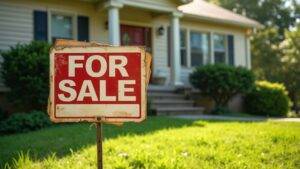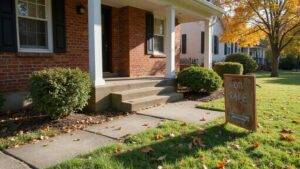Vacant houses face unique risks when left unoccupied before a sale. These homes can attract thieves, vandals, or squatters. Damage or loss from break-ins often lowers the final sale price.
Such problems can cost you time and money. You might also struggle to convince buyers the house is a safe investment. Unaddressed security issues could scare off serious offers or delay the sale process.
The best way to secure a vacant house before selling is to follow a safety checklist and take preventive steps. Lock all doors and windows, install lighting, and consider smart security devices.
These actions will keep your property safe and ready for showings. This blog will guide you through easy, effective steps to protect your vacant house before listing it for sale.
Key Takeaways
- Install high-quality locks, reinforce vulnerable entry points, and use security bars on sliding doors and windows.
- Set up security cameras, motion-activated lights, and remote monitoring systems to deter intruders and monitor activity.
- Regularly inspect the property, maintain landscaping, and ensure exterior lighting is functional to keep the house looking occupied.
- Remove valuables, store important items off-site, and keep an updated inventory list for added protection.
- Notify local police and trusted neighbors about the vacancy, and arrange for mail and deliveries to be collected or held.
Assess Potential Security Risks
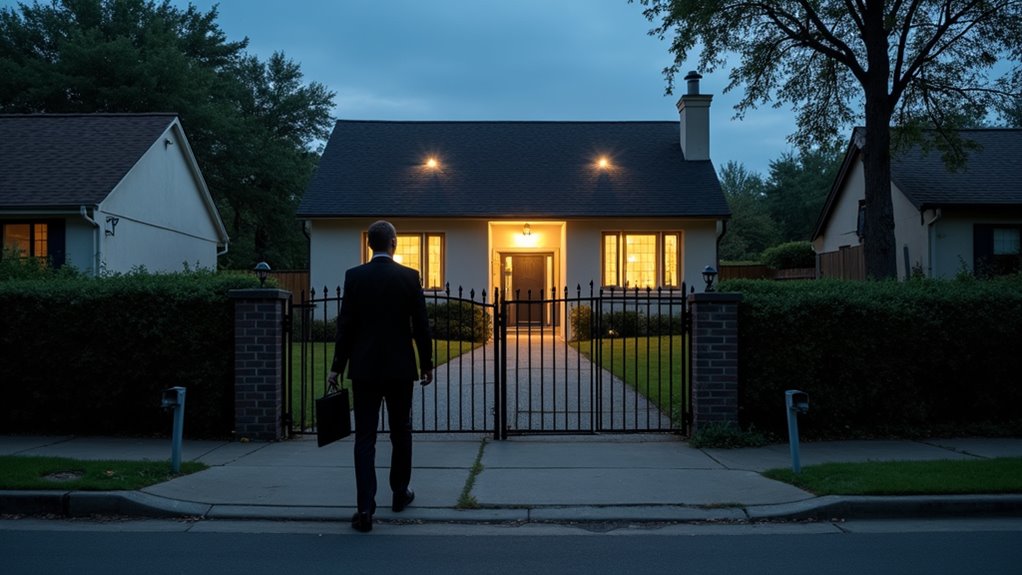
Assessing potential security risks starts with a close look at the house and its features. Every property has different weak spots that need attention. Identifying these is the first step to better security.
Inspect all doors and windows, especially those hidden from view. If you see overgrown bushes or trees, trim them to remove cover for intruders. Well-lit areas can discourage criminal activity. Consider if the house is easy to see from the street or by neighbors. Security cameras should cover doors, windows, and any hidden spots.
If you install an alarm system, choose one that fits the home’s needs. Addressing property condition can also help strengthen security and attract serious buyers. Check doors and windows that are out of sight, clear away overgrown plants, and ensure good lighting to help deter intruders.
If you find any weaknesses, address them as soon as possible. A clear plan can help protect the house from break-ins. Fixing issues early makes the property safer.
Taking these steps not only improves safety, but can also boost curb appeal and make your property more attractive to potential buyers.
Install Quality Locks on All Doors and Windows
Install quality locks on every door and window to protect your home. Use strong deadbolts for exterior doors. Pick reinforced locks for all windows.
Burglars often look for weak locks. If you upgrade old or flimsy hardware, you make entry much harder. Sliding doors need security bars or pin locks.
Visible security signs can discourage intruders. Proper strike plates and long screws make doors stronger. Window locks should block forced entry and tampering. Security upgrades like reinforced window locks are especially important for homes that may have been weakened by previous incidents, such as fire or vandalism.
Alarm systems give extra protection. However, strong locks are your main defense. Every entry point should show your focus on safety.
When selling a house after divorce in Virginia, proper documentation of security upgrades, such as new locks, can help streamline the sale and ensure legal compliance.
Secure the Garage and Outbuildings

Don’t overlook your garage and outbuildings, as these can be easy targets for intruders. Reinforce all garage entry points with sturdy locks, and ensure any connecting doors to the house are just as secure. Lock sheds and storage units with heavy-duty padlocks to keep tools and valuables safe.
For added protection, make sure these areas are decluttered and depersonalized to reduce their appeal to would-be thieves and help maintain a tidy, inviting appearance for potential buyers. It’s also wise to disclose all known violations related to these structures to meet legal obligations and avoid complications during the sale process.
Reinforce Garage Entry Points
Garage entry points must be reinforced to protect your home. Many homeowners forget the garage, making it a weak spot. Secure the garage first to boost overall safety.
Inspect all garage doors and side entrances for any damage or weak locks. Add a heavy-duty padlock or an interior slide bolt to overhead doors. Install deadbolts and strong strike plates on access doors.
Consider upgrading to a smart garage door opener if you want extra security. Use rolling-code technology to prevent code theft. Install motion-sensor lights outside the garage to scare off intruders.
If your garage has an emergency release cord, hide or remove it. This step blocks a common way for intruders to break in. Taking these actions will make your property much safer before selling.
Lock Sheds and Storage
Sheds and storage buildings need strong security to prevent theft. Thieves often target these places for tools or equipment. Always use a sturdy, weatherproof padlock on every door.
Replace any weak doors or broken windows right away. Security bars can stop someone from getting in through windows. You can also install motion-activated lights to scare off intruders at night.
Always lock sheds and storage units after each use. If you remove valuable items, thieves have less reason to break in. Placing a sign saying “no valuables inside” may also discourage theft.
Here’s a quick comparison of common security upgrades:
| Upgrade | Benefit |
|---|---|
| Heavy-duty padlocks | Deters forced entry |
| Security bars | Prevents window access |
| Motion lights | Increases visibility |
| Door reinforcement kits | Strengthens entry points |
| Visible “no valuables” sign | Discourages thieves |
Use Timers for Interior and Exterior Lights
Timers help make your home look occupied, which can prevent break-ins. You should use timers for both indoor and outdoor lights. Timers turn lights on and off automatically, especially in the evening.
Place timers in different rooms so lights turn on at varied times. Exterior timers should control security lights near doors and dark corners. This setup can scare off intruders if they see the lights change. Remember, improving curb appeal also plays a role in deterring unwanted attention and attracting buyers.
If you use timers, avoid setting all lights to the same schedule. Choose LED bulbs to save energy and make bulbs last longer. Connect timer schedules with your alarm system for extra security.
If you’re preparing your property for sale, using timers is just one part of a hassle-free experience for sellers seeking efficiency and security before closing.
Maintain the Yard and Exterior Appearance

Keep your yard tidy to show the home is cared for. Overgrown grass and messy landscaping can attract unwanted attention. Regular lawn care and prompt debris removal help maintain a lived-in look.
If you are away, hire someone to mow the lawn and trim bushes. Fresh mulch and seasonal flowers can boost curb appeal. These steps make the house appear occupied. Ensuring your property looks maintained can also help attract serious buyers in Grottoes, VA.
Check that exterior lights work well. Replace broken bulbs and clean light fixtures if needed. Well-lit areas can discourage trespassers and keep your property safe.
If you’re considering selling, working with buyers who purchase houses in any condition can save you the hassle of extensive yard and exterior maintenance before listing.
Remove Valuable Items From the Property
Start by identifying high-risk valuables such as electronics, jewelry, and important documents that could attract thieves. Arrange for these items to be stored temporarily in a secure location, like a trusted person’s home or a safety deposit box. As you remove them, document each item to keep a clear inventory for your records and insurance purposes.
Removing valuables also helps streamline the process if you decide to sell your house as-is for cash, since buyers in Waynesboro often purchase properties without requiring repairs or cleaning. Remember, proper documentation of inspections and valuables helps ensure transparency and legal compliance, especially if there are issues related to mold or water damage that must be disclosed to future buyers.
Identify High-Risk Valuables
To secure a vacant house, first find and remove high-risk valuables. Thieves often target items that are small and easy to steal. Removing these items lowers the risk of a break-in.
Walk through each room and make a list of valuables. Electronics, jewelry, and important documents are common targets. Outdoor tools and garden equipment can also attract thieves.
If you leave valuables behind, they may increase the chance of theft. Removing them helps protect the house and makes it easier to sell. Always address valuables before other security steps.
Arrange Temporary Secure Storage
Valuables should not stay in a vacant house. Move them to a secure storage facility while the property is empty. This step lowers the risk of theft or damage.
High-value items include electronics, jewelry, important documents, and rare collectibles. If you must keep them on-site, use a hidden and locked space. Otherwise, choose a reputable storage company with good security.
A reliable storage facility should have cameras, restricted entry, and climate control if needed. If you hire movers, check their credentials and insurance. Moving valuables off-site makes it easier to show the house to buyers.
Document Items for Inventory
To make sure you do not miss anything in a vacant house, start by making a clear inventory list. List every item that stays in the house. Use photos and simple descriptions for each item.
If you have valuable items, write down their serial numbers. Take photos of these valuables as proof. Remove all important items from the property before you list it.
If you want extra protection, check your camera locations. Change the angles to cover entry points and storage areas. Choose an alarm system with remote monitoring if needed.
You should save your inventory list in a safe place online. If you review your list and security often, you lower the risk of loss. This helps keep your property and your mind safe.
Set Up a Security System
A security system keeps a vacant house safe from break-ins and damage. If you do not live there, you should install one. Good security protects your property until the house is sold.
Choose an alarm system with remote monitoring and mobile alerts. These features let you know if something unusual happens right away. If you want more control, pick a system you can manage from your phone. It’s also helpful to consult a real estate expert to ensure your security measures align with local expectations and market trends.
Place cameras at all entry points, such as doors, windows, and the garage. Cameras should also cover the front and backyard. Visible cameras can scare away people who may want to break in.
Motion-activated lights help your cameras work better at night. Signs that say the property is under surveillance can further deter trespassers. If you follow these steps, your home will be much safer.
When selling your home as-is in Virginia, taking extra precautions with security is especially important because the property may attract more attention from investors or opportunists.
Notify Local Law Enforcement of Vacancy
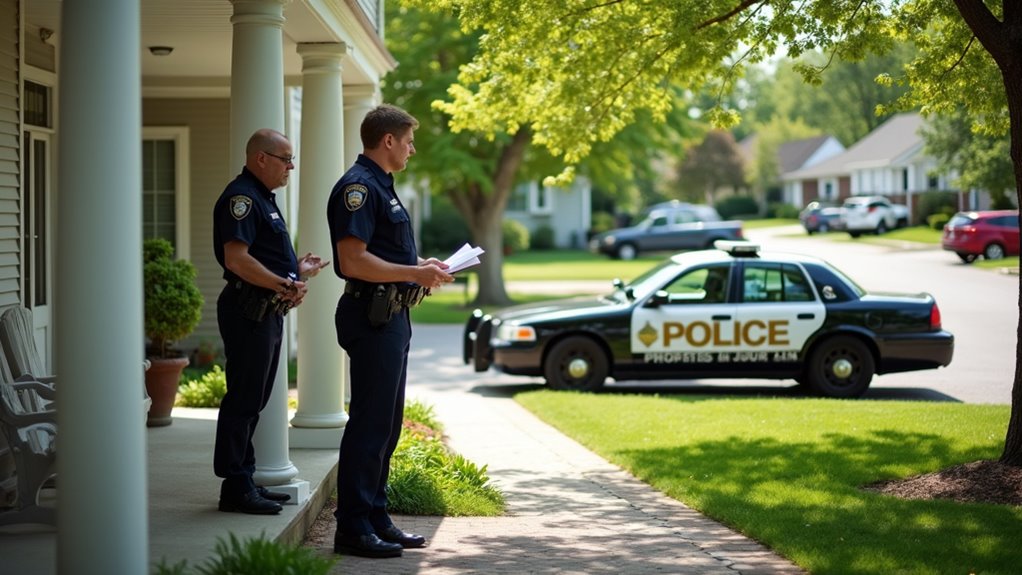
Tell your local police if your house will be empty. Police can help watch your property when it is vacant. This step makes your home safer and meets legal requirements.
You should give police your contact information and the dates your house will be empty. Police may drive by your home more often if they know it is vacant. If something happens, they will know how to reach you.
If you want to protect your empty home, notifying police is a good idea. This action shows you are careful and responsible. Use local resources to keep your property secure while it is for sale.
In Broadway, working with a local team for personalized support can also help ensure your vacant property is monitored and secure throughout the selling process.
Ask Neighbors to Keep an Eye Out
Enlist trusted neighbors to participate in a neighborhood watch, ensuring multiple sets of eyes monitor your property. Share your emergency contact information so they can reach you or the authorities quickly if they notice anything suspicious. This coordinated approach adds a critical layer of security while your house remains vacant.
Neighborhood Watch Collaboration
Working with a neighborhood watch helps protect your vacant house. Neighbors can watch for suspicious activity and share alerts quickly. This adds another layer of security.
You should tell trusted neighbors and the watch group when your house is empty. If you have concerns, let them know what to look for. They can contact you if they notice anything unusual.
If you want better results, coordinate patrol times with neighbors. Sign up for local alert systems to receive updates fast. Give neighbors a list of people who may visit your property.
Active involvement in a neighborhood watch helps protect your house. It also creates a safer and more alert community. Everyone benefits from working together.
Emergency Contact Information
Neighbors need your current emergency contact information to watch your vacant house. List your phone number and an alternate contact. Add your property manager’s or real estate agent’s number if you have one.
State the best way to reach you, such as by call or text. Give clear written instructions for emergencies like water leaks or broken windows. If possible, tell them where to find shut-off valves and breakers.
Update your contact details regularly to keep them accurate. Make sure trusted neighbors can easily find this information. This helps them respond quickly and prevent further damage.
Block Mail and Package Deliveries
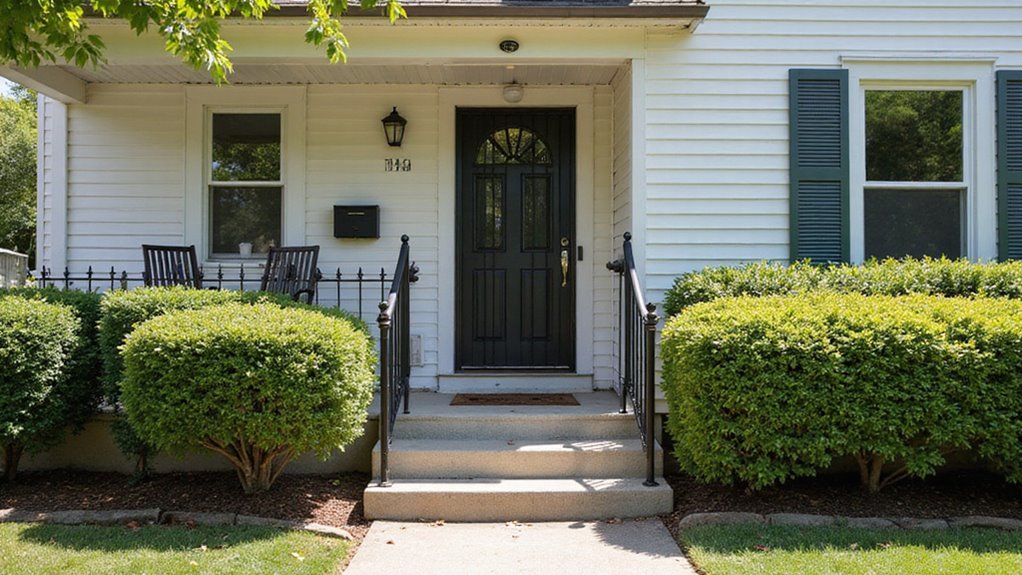
To block mail and package deliveries, you need to stop all regular deliveries before leaving your home. Unattended mail or packages can show that your house is empty. This makes your home a target for theft.
You should request a mail hold or forwarding service from your post office. If you cannot do this, ask a trusted neighbor to collect your mail. Overflowing mailboxes attract attention.
Update your online shopping accounts with a different delivery address. You can also schedule package pickups at local carrier offices. If any deliveries are missed, ask a neighbor to check your porch.
These steps help protect your vacant home from becoming an easy target. Taking action before you leave is important. Proper planning keeps your property safe.
Use Smart Technology for Remote Monitoring
Smart technology helps you monitor your vacant house from a distance. It sends instant alerts if anything unusual happens. If you use these systems, you can act quickly in case of problems.
Many devices connect to your smartphone. You can see camera feeds or control locks from anywhere. If you need to check the house, you can do it without being there.
Here is a quick comparison of some smart security features:
| Feature | Benefit |
|---|---|
| Motion sensors | Spot movement in the house |
| Security cameras | Show live video of your home |
| Smart door locks | Let you lock or unlock doors remotely |
If you invest in smart monitoring, your property stays safer. These tools help protect your house until it is sold.
Regularly Inspect the Property
You should regularly inspect your property in person. Physical inspections help you find problems that cameras or sensors might miss. These visits let you spot broken windows, leaks, or signs of tampering.
If you want to keep your house secure, check all security lights and cameras during each visit. Make sure lights work, motion sensors respond, and cameras record clear footage. Regular inspections show that someone is watching the property.
Always look for forced entry or vandalism. If you see flyers, mail, or trash outside, remove them right away. These checks keep your property safe and ready for sale.
Board Up Vulnerable Entry Points if Necessary
Boarding up weak entry points helps protect a vacant house from break-ins and bad weather. You should first find all easy ways to get inside, like broken windows or weak doors. If you notice damage, act quickly to cover these spots.
Windows need strong plywood cut to fit over them. Heavy-duty screws will keep the boards in place and stop unwanted entry. Proper boarding also shields the inside from wind and rain.
Doors may need extra support with metal plates or brackets. If a door is too weak, it is best to board it up completely. Always secure ground-level entrances first since they are the most at risk.
Review and Update Homeowner’s Insurance
Check that your homeowner’s insurance specifically covers vacant properties, as many standard policies don’t. Notify your insurance provider as soon as the house becomes unoccupied, since failing to report this change could void your coverage. Adjust your policy to address increased risks like vandalism, theft, and weather damage to ensure you’re fully protected.
Verify Vacant Property Coverage
Most homeowner’s insurance does not fully protect vacant homes. Standard policies often stop coverage if a house is empty for over 30–60 days. This can leave you without protection for risks like theft or weather damage.
You should always check your policy’s vacancy clause. It explains when coverage ends and what risks are excluded. If you do not check, you may face problems during a claim.
It is important to confirm what risks are covered. Make sure events like fire or break-ins are listed. If something is missing, you may need extra coverage.
Some insurers require you to add special endorsements for vacant homes. These endorsements or separate policies are often necessary. If you are unsure, contact your insurance agent for help.
Notify Insurance Provider Promptly
You must notify your insurance provider if you plan to leave your home vacant for a while. Most home insurance policies have special rules for empty houses. Telling your insurer keeps your coverage valid.
Some policies do not cover damage if the home is vacant. You should give your insurer the dates your home will be empty. Accurate information helps them update your policy and explain any changes.
If you do not tell your insurer, you might lose coverage for some risks. Quick communication helps if you need to file a claim later. Always check your policy and ask your insurer if you are unsure about coverage.
Adjust Policy for Risks
You should update your homeowner’s insurance policy when your home will be empty. Standard policies often do not cover certain risks if a house is vacant for more than 30 days. If this is your situation, you must take extra steps to protect your property.
Contact your insurance provider to discuss your options for empty homes. You may need to add a vacant house endorsement or buy a policy designed for unoccupied homes. If you make security upgrades, you should tell your insurer and keep records.
Check for policy exclusions or limits related to vacancy. Some insurers require alarm systems or regular home inspections for empty homes. Consider extra coverage for risks like property damage, break-ins, or liability issues.
Conclusion
If you secure a vacant house before selling, you reduce the risk of damage or theft. Taking simple steps like installing lights, using cameras, and asking neighbors to watch the property can make a difference. A well-maintained and secure home is more attractive to potential buyers.
If you want to sell quickly, remember that we buy houses for cash. This option can save you time and effort, especially if you are concerned about the property sitting vacant. Cash buyers often handle repairs and security themselves, making the process easier for you.
If you are ready to sell or need help with a vacant property, we at Align Real Estate Solutions are here to assist. We offer fair cash offers and can close quickly. Connect with us today to learn how we can help you secure your sale.
Author
-

Zach Koops is co-founder and Real Estate Success Manager at Align Real Estate Solutions, serving homeowners across Virginia since 2024. With a passion for real estate and a heart for people, Zach has built his career around helping sellers navigate tough situations—foreclosure, inheritance, relocation, repair-overload—with clarity and compassion. He’s known for being straightforward, steady under pressure, and deeply invested in relationships. Outside of work, he spends his time as a husband and father, enjoys the outdoors in Shenandoah Valley, loves singing on stage, and constantly seeks growth through reading and new experiences.






